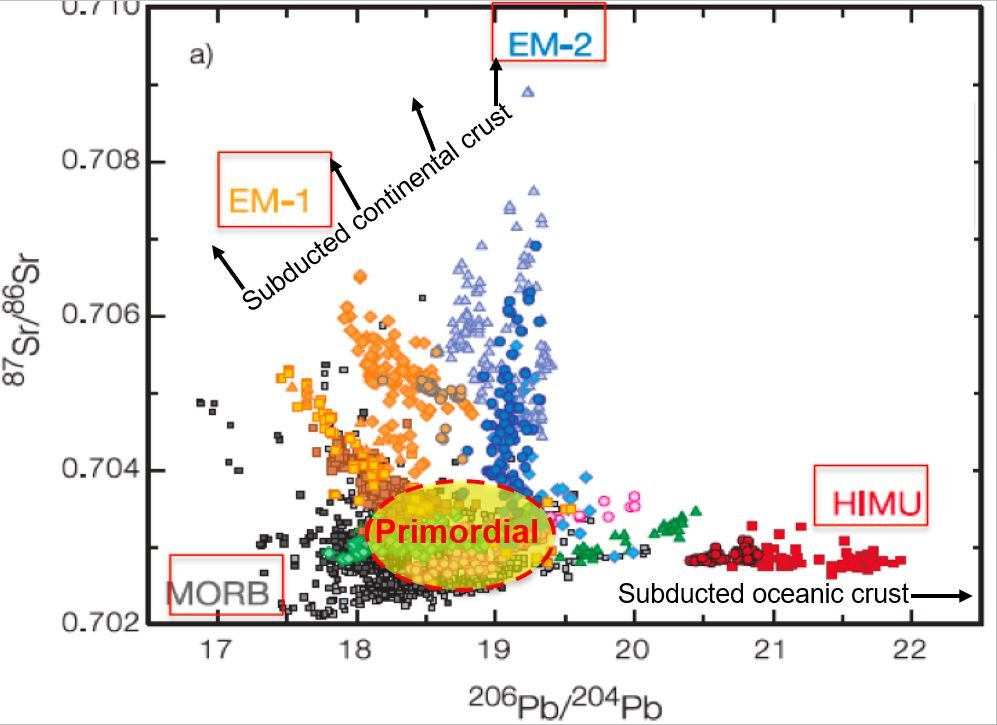Matt Jackson on the Heterogeneity of the Mantle
Matt Jackson is a Professor of Earth Science at the University of California, Santa Barbara. He probes the chemical composition of the mantle by analyzing trace elements and isotopes in hot-spot lavas from around the world. In the podcast, he describes the intriguing heterogeneity among the hot-spots of the so-called “hot-spot highway” in the western Pacific. The heterogeneity there, as well as on larger spatial scales, is challenging our ideas about the motions of the mantle over the billions of years of Earth history.
Listen to the podcast here or wherever you listen to podcasts.
Scroll down for illustrations that support the podcast.
Note - playing the podcast is not supported on Internet Explorer; please use any other browser, or listen on Spotify, Apple Podcasts, etc.
Podcast Illustrations
Images courtesy of Matt Jackson unless otherwise indicated.
The R/V Kilo Moana is an oceanographic research vessel with equipment for geophysical, physical oceanographic, meteorological, and radioisotope research. This is the vessel Matt Jackson used for his expedition to the western Pacific in early 2022 to sample deep-sea lavas from hot-spots of the “hot-spot highway.”
Courtesy of the University of Hawaii
Sigsbee dredge design, 1880 (left).
Modern dredge being lowered into the water (right) and returning full of sea-floor rocks (far right).
Courtesy of Science party, RR1310 expedition
Courtesy of Evelyn Mervine
Hot-spot location map. The dot colors indicate how far each hot-spot is from a large low-shear-velocity province (LLSVP). Red, orange, and yellow dots lie within the LLSVP zone, and blue dots lie the farthest away. The LLSVPs are shown as the yellow regions.
Jackson, M.G et al. (2018), Geochem. Geophys. Geosyst. 19 doi:10.1029/2018GC007552
Hot-spots in the Pacific. The trail of extinct volcanos from the Samoan hot-spot and the Rurutu hot-spot (also known as the Arago hot-spot) can be traced for at least 100 million years before they subduct at the Mariana Trench. The Hawaiian trail is cut off at an age of 78 million years by subduction at the Kuril–Kamchatka Trench.
Courtesy of Jasper Konter and Matt Jackson
Enlargement of a portion of the figure above showing the overlapping hot-spot trails of the hot-spot highway in the western Pacific. Using radiometric dating and geochemical analysis, we can associate each seamount to its parent hot-spot, as indicated with the color-coded diagram of the seamounts along the bottom of the map.
Jackson, M.G. et al. (2010), Geochem. Geophys. Geosyst. 11, doi:10.1029/2010GC003232.
High-resolution sonar map of a seamount in the hot-spot highway region near American Samoa. The resolution and reliability are orders of magnitude better than that of the satellite gravity-based sea-floor surveys, but only small regions can be mapped in this way since the exercise is very time-consuming. Such maps reveal zones of high sonar reflectivity that indicate a relative lack of sonar-absorbing sedimentary cover. This in turn suggests that the bedrock lava may be exposed, and therefore accessible to the dredge. Steeply sloping areas are also preferred, since coral and other surface material are more likely to have been sloughed off there. The contour lines show 100 m depth intervals, and background color represents the product of sonar reflectivity and slope: Warm colors indicate surfaces that are both steep and reflective, representing ideal dredging targets. Four dredge targets are shown as red lines. This seamount is about 17 miles across. For comparative purposes, the R/V Kilo Moana is smaller than the degree (°) symbols on the axes of the figure.
Courtesy of Zach Eilon
The diagram illustrates the standard model whereby material from subducting plates mixes with regions of the mantle and imparts characteristic trace element signatures on them. HIMU is a mantle reservoir containing a high uranium-to-lead ratio arising from recycling oceanic crust over billions of years. Other signatures (EM1, EM2) reflect recycling and long-term storage of materials derived from continental crust. The recycled material constitutes anywhere from less than a percent to 10 percent of the enriched mantle region.
Workman et al. (2004), Geochem. Geophys. Geosyst., 5, Q04008
Plot of strontium isotope ratios vs. lead isotope ratios for oceanic hot-spot lavas from various localities. The partitioning into the different regions of the plot provides one type of geochemical signature that distinguishes the different mantle reservoirs. MORB = mid-ocean ridge basalt. HIMU = high uranium-to-lead ratio from ancient subducted oceanic crust. EM1 and EM2 are associated with ancient subducted continental crust.
Willbold et al. (2006), Geochem. Geophys. Geosyst. (2006) 10.1029/2005GC001005
Positions of the continents at present and at 500 million years ago. A. Pre-Mesozoic (i.e., older than about 250 million years) continental plates are shown in dark grey with present continental outlines in light grey for reference. The location of oceanic enriched mantle (EM) hot-spots are shown as red circles, and the continental and non-enriched mantle oceanic hot-spots are shown as blue squares. The pink shaded regions delineate the large low-shear-velocity provinces. B. Reconstruction of continents at 500 million years ago showing that the distribution of continents was primarily in the southern hemisphere during the formation of the Gondwana supercontinent. In the podcast, Matt Jackson suggests that the hot-spots in the southern hemisphere may have enriched mantle signatures resulting from mixing with subducted continental or continent-derived material associated with the assembly of Gondwana.
Jackson et al. (2021), submitted to Nature https://doi.org/10.31223/X5NP7V
Xenolith from the Samoan hot-spot. The xenolith is primarily composed of the minerals olivine (large bright green minerals) with lesser abundances of orthopyroxene (large dark green minerals) and minor amounts of clinopyroxene (small apple green grains that are difficult to make out in the image) and spinel (small dark grains). Matt Jackson found an unexpectedly large variation in trace element and isotopic composition between different clinopyroxene crystals within this 3 cm sample. This tells us that inhomogeneities in the mantle exist on very small scales.













